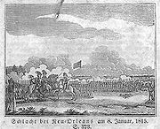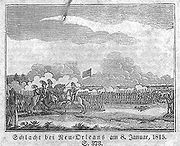
German Coast
Encyclopedia
The German Coast was a region of early Louisiana
settlement located above New Orleans on the Mississippi River
– specifically, from east to west, in St. Charles, St. John the Baptist
, and St. James parishes of present-day Acadiana
. The four settlements along the coast were Karlstein, Hoffen, Meriental, and Augsburg. Originally, the Germans settled at the Arkansas Post, however the conditions were intolerable. The area's name was derived from the large population of German
pioneers who were settled there in 1721 by John Law
and the Company of the Indies
. When the company folded in 1731, the Germans became independent land-owners.
Despite periodic flooding, hurricanes, and the rigors of frontier life, the German pioneers made a success of their settlements. Their farming endeavors provided food not only for themselves but also for New Orleans' residents. Some historians credit these German farmers with the survival of early New Orleans.
 In 1768, they joined with Acadians from the Cabannocé Post area to march on New Orleans and overthrow Spanish colonial governor Antonio de Ulloa
In 1768, they joined with Acadians from the Cabannocé Post area to march on New Orleans and overthrow Spanish colonial governor Antonio de Ulloa
. The German and Acadian settlers united again, under Spanish colonial governor Bernardo de Gálvez, to fight the British
during the American Revolution
.
Most of the German Coast settlers hailed from the Rhineland
region of Germany, the German-speaking cantons of Switzerland
, and other places today called, Bayou des Allemands and Lac des Allemands (meaning Germans' Bayou and Germans' Lake, in French). Many Germans came from the German-speaking region of Alsace-Lorraine
in France, and some from Switzerland
and Belgium
.
From the time of their arrival, the German immigrants began speaking French and intermarried with the early French settlers; and over the subsequent decades they intermarried with the descendants of the latter as well as the Acadians. Together with other settlers, they helped create Cajun
culture. For example: German settlers introduced the diatonic accordion
to the region, which become the main instrument in Cajun music
by 1900.
The German Coast was the site of the largest slave revolt in US history, the 1811 German Coast Uprising
. One of the leaders was Charles Deslondes, a free person of color from Haiti
, who gathered more than 200 slaves from plantations along the River Road and marched toward New Orleans. The insurgents killed two white men before meeting much resistance, but were not well armed. Ninety-five slaves were killed by the militia or in executions after quick trials.
During World War I, in a reaction against Germany as the enemy, the Louisiana
state legislature passed Act 114 which made all expressions of German culture and heritage, especially the printed or spoken use of the German language, illegal in the state.
Louisiana
Louisiana is a state located in the southern region of the United States of America. Its capital is Baton Rouge and largest city is New Orleans. Louisiana is the only state in the U.S. with political subdivisions termed parishes, which are local governments equivalent to counties...
settlement located above New Orleans on the Mississippi River
Mississippi River
The Mississippi River is the largest river system in North America. Flowing entirely in the United States, this river rises in western Minnesota and meanders slowly southwards for to the Mississippi River Delta at the Gulf of Mexico. With its many tributaries, the Mississippi's watershed drains...
– specifically, from east to west, in St. Charles, St. John the Baptist
St. John the Baptist parish
St. John the Baptist parish may refer to one of a number of religious organisations:In the district of Clontarf, Dublin, Ireland:* The Church of Ireland Parish of Clontarf* The senior Parish of Clontarf...
, and St. James parishes of present-day Acadiana
Acadiana
Acadiana, or The Heart of Acadiana, is the official name given to the French Louisiana region that is home to a large Francophone population. Of the 64 parishes that make up Louisiana, 22 named parishes and other parishes of similar cultural environment, make up the intrastate...
. The four settlements along the coast were Karlstein, Hoffen, Meriental, and Augsburg. Originally, the Germans settled at the Arkansas Post, however the conditions were intolerable. The area's name was derived from the large population of German
Germans
The Germans are a Germanic ethnic group native to Central Europe. The English term Germans has referred to the German-speaking population of the Holy Roman Empire since the Late Middle Ages....
pioneers who were settled there in 1721 by John Law
John Law (economist)
John Law was a Scottish economist who believed that money was only a means of exchange that did not constitute wealth in itself and that national wealth depended on trade...
and the Company of the Indies
Mississippi Company
The "Mississippi Company" became the "Company of the West" and expanded as the "Company of the Indies" .-The Banque Royale:...
. When the company folded in 1731, the Germans became independent land-owners.
Despite periodic flooding, hurricanes, and the rigors of frontier life, the German pioneers made a success of their settlements. Their farming endeavors provided food not only for themselves but also for New Orleans' residents. Some historians credit these German farmers with the survival of early New Orleans.

Antonio de Ulloa
Antonio de Ulloa y de la Torre-Girault was a Spanish general, explorer, author, astronomer, colonial administrator and the first Spanish governor of Louisiana.Rebellion of 1768]]....
. The German and Acadian settlers united again, under Spanish colonial governor Bernardo de Gálvez, to fight the British
Kingdom of Great Britain
The former Kingdom of Great Britain, sometimes described as the 'United Kingdom of Great Britain', That the Two Kingdoms of Scotland and England, shall upon the 1st May next ensuing the date hereof, and forever after, be United into One Kingdom by the Name of GREAT BRITAIN. was a sovereign...
during the American Revolution
American Revolution
The American Revolution was the political upheaval during the last half of the 18th century in which thirteen colonies in North America joined together to break free from the British Empire, combining to become the United States of America...
.
Most of the German Coast settlers hailed from the Rhineland
Rhineland
Historically, the Rhinelands refers to a loosely-defined region embracing the land on either bank of the River Rhine in central Europe....
region of Germany, the German-speaking cantons of Switzerland
Switzerland
Switzerland name of one of the Swiss cantons. ; ; ; or ), in its full name the Swiss Confederation , is a federal republic consisting of 26 cantons, with Bern as the seat of the federal authorities. The country is situated in Western Europe,Or Central Europe depending on the definition....
, and other places today called, Bayou des Allemands and Lac des Allemands (meaning Germans' Bayou and Germans' Lake, in French). Many Germans came from the German-speaking region of Alsace-Lorraine
Alsace-Lorraine
The Imperial Territory of Alsace-Lorraine was a territory created by the German Empire in 1871 after it annexed most of Alsace and the Moselle region of Lorraine following its victory in the Franco-Prussian War. The Alsatian part lay in the Rhine Valley on the west bank of the Rhine River and east...
in France, and some from Switzerland
Switzerland
Switzerland name of one of the Swiss cantons. ; ; ; or ), in its full name the Swiss Confederation , is a federal republic consisting of 26 cantons, with Bern as the seat of the federal authorities. The country is situated in Western Europe,Or Central Europe depending on the definition....
and Belgium
Belgium
Belgium , officially the Kingdom of Belgium, is a federal state in Western Europe. It is a founding member of the European Union and hosts the EU's headquarters, and those of several other major international organisations such as NATO.Belgium is also a member of, or affiliated to, many...
.
From the time of their arrival, the German immigrants began speaking French and intermarried with the early French settlers; and over the subsequent decades they intermarried with the descendants of the latter as well as the Acadians. Together with other settlers, they helped create Cajun
Cajun
Cajuns are an ethnic group mainly living in the U.S. state of Louisiana, consisting of the descendants of Acadian exiles...
culture. For example: German settlers introduced the diatonic accordion
Accordion
The accordion is a box-shaped musical instrument of the bellows-driven free-reed aerophone family, sometimes referred to as a squeezebox. A person who plays the accordion is called an accordionist....
to the region, which become the main instrument in Cajun music
Cajun music
Cajun music, an emblematic music of Louisiana, is rooted in the ballads of the French-speaking Acadians of Canada. Cajun music is often mentioned in tandem with the Creole-based, Cajun-influenced zydeco form, both of Acadiana origin...
by 1900.
The German Coast was the site of the largest slave revolt in US history, the 1811 German Coast Uprising
1811 German Coast Uprising
The 1811 German Coast Uprising was a slave revolt that took place in parts of the Territory of Orleans on January 8–10, 1811. The revolt took place on the east coast of the Mississippi River in what are now St. John the Baptist and St. Charles Parishes, Louisiana. While the slave insurgency was...
. One of the leaders was Charles Deslondes, a free person of color from Haiti
Haiti
Haiti , officially the Republic of Haiti , is a Caribbean country. It occupies the western, smaller portion of the island of Hispaniola, in the Greater Antillean archipelago, which it shares with the Dominican Republic. Ayiti was the indigenous Taíno or Amerindian name for the island...
, who gathered more than 200 slaves from plantations along the River Road and marched toward New Orleans. The insurgents killed two white men before meeting much resistance, but were not well armed. Ninety-five slaves were killed by the militia or in executions after quick trials.
During World War I, in a reaction against Germany as the enemy, the Louisiana
Louisiana
Louisiana is a state located in the southern region of the United States of America. Its capital is Baton Rouge and largest city is New Orleans. Louisiana is the only state in the U.S. with political subdivisions termed parishes, which are local governments equivalent to counties...
state legislature passed Act 114 which made all expressions of German culture and heritage, especially the printed or spoken use of the German language, illegal in the state.

